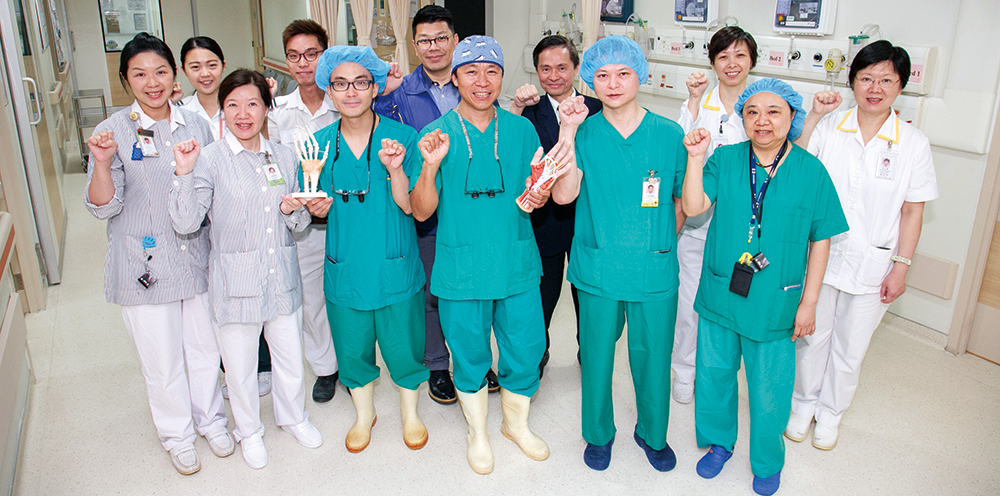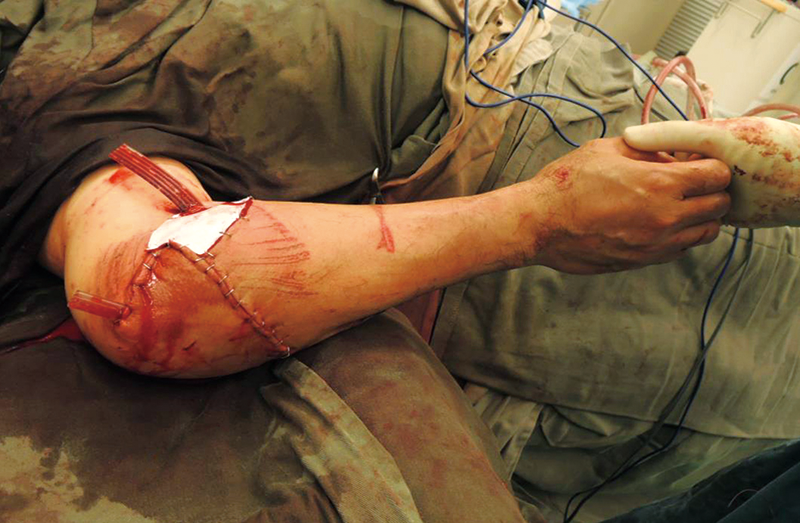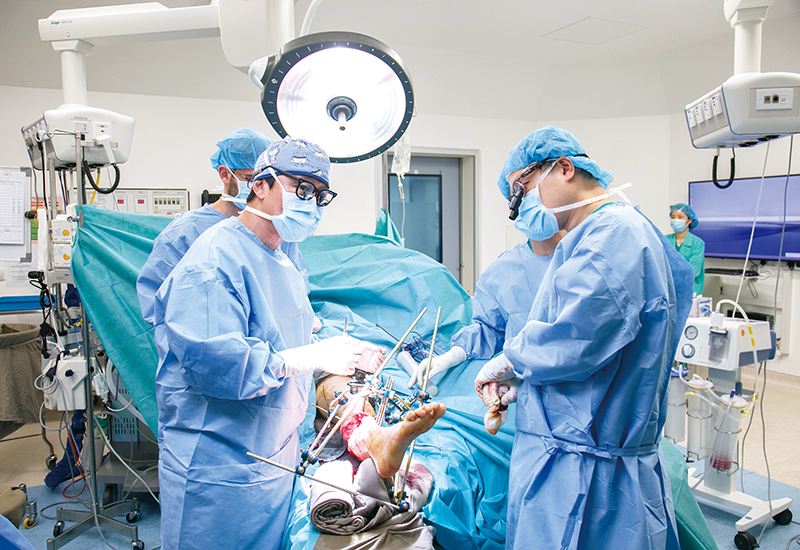NTEC Replantation Team
New Territories East Cluster
Replant for a complete body in all endeavours
As the first and only cluster-wide replantation team in Hong Kong, New Territories East Cluster (NTEC) Replantation Team adheres to the spirit of ‘replant always as far as feasible and appropriate’ to help patients find their way back to normal life. In the past 15 years, the team has carried out replantation surgeries for over 230 patients, most of which were replantation of upper limbs (from upper arm to finger tips), 80% of the patients of successful cases can return to their original work prior to injury.
Dr Ho Pak-cheong, Chief of Service of Department of Orthopaedics & Traumatology at Prince of Wales Hospital (PWH) and Alice Ho Miu Ling Nethersole Hospital (AHNH) explains that the major causes of mutilation accidents have changed from industrial accidents in the 80s to domestic and traffic accidents in recent years. Generally speaking, replantation of upper limbs is more important than that of lower limbs, as current technology is yet to allow prosthetic upper limbs to function just as the real ones. Compared with upper limbs, the technology of prosthetic lower limbs is more advanced and they function pretty much as well as real limbs.
Regardless of how good prosthetics function, the team still prioritises replantation. Dr Ho says, “It’s likely for patients to have certain lasting psychological trauma when they lose a part of their originally complete body.” He explains further with an example: a police constable broke his fingertip in a traffic accident when he was on duty at Tolo Harbour. Even years after his fingertip was replanted, the police constable admitted that he would have been traumatised if his finger was mutilated. Body parts as tiny as a fingertip can indeed cause unignorably far-reaching adverse psychological effects.
However, hard work does not always promise success. Over 10 years ago, a teenager had four fingers mutilated by a fish ball-making machine. The team spent over 10 hours to help him replant the four fingers, but these replanted fingers started to turn blue and pale and show a purulent discharge on the very next day. Results from evaluations showed that the fingers might have already been heavily infected by nasty bacteria in the machine. The fingers were beyond salvage and needed to be removed reluctantly. The team eventually transplanted a toe of the teen as his new ‘middle finger’, which he could use, together with his thumb, to lift up a folded chair a year later.
Dr Ho emphasises how highly complex replantation surgeries are and accident can happen anytime and so as the need for emergency surgery. Each surgery may thus last for over 10 hours. It is not sustainable to allocate all surgeries of this kind to one to two doctors in only one hospital. Therefore, the NTEC Replantation Team was established in June 2002 to make good use of resources in the cluster and the manpower of specialists in the Department of Orthopaedics & Traumatology at PWH, North District Hospital and AHNH, who will work on rota for better synergy. Specialist nurses from these hospitals will also work under the team coordination to provide intensive post-operative care and monitoring, and physiotherapists and occupational therapists will follow up on the rehabilitation training and recovery progress of patients.
Should mutilated limb be stored in ice?
Rinse the mutilated limb with clean water (such as bottled mineral water), put it in a clean water-resistant plastic bag. Then place the bag in cold water with ice at a temperature at around four degree Celsius. After that, send it to hospital as soon as possible to reduce the chance of tissue decay due to the lack of blood. A patient had once put ice in a thermal rice pot surrounding the mutilated finger. Since the ice was too cold, the cellular tissues were all frozen to death and the finger could not be replanted.
How to evaluate if the replanted limb is in good conditions?
48 to 72 hours after surgery is a critical period for observation – the surface temperature of the replanted limb should not differ from that of the normal limb by three degree Celsius. If the replanted limb shows a pale white or bruised colour with poor capillary response, the blood vessels in the limb may be blocked. It is an extremely critical condition that requires prompt surgery for revival.
How difficult is it to replant a mutilated limb?
The surgery is difficult and complicated as it deals with the connection of tiny and complex structures and tissues that are even thinner than hair such as arteriovenous blood vessels, nerves, tendons, muscles, and bones. It often lasts for more than 10 hours and may include grafting of various types of body tissues to replenish deficits. Surgeons often practise the connection of blood vessels and nerves with tails of mice or chicken feet because they share similar sizes with human vessels and nerves.
● Young Achievers pull out all the stops
YOUNG ACHIEVER
● List of young achiever winners
● Small screw makes a big difference in ward
● The compass of healthcare planning
● Passionate scientist develops rapid tests
● Master key man starts occupational safety from staircases
● Fully committed to saving lives from heart
● Nurses light up in patients’ limping road of treatment
● Practical upgrade quality and quantity of PCI service in acute myocardial infarction
● Exercise is key to rehabilitation
● Quick training for new nurses to meet challenges at ease
OUTSTANDING STAFF
● List of outstanding staff winners
● Creative handicrafts help patients restore confidence
● Bring joy to kids during journey against disease
● Pioneer transforms nurse clinic into an integrated sanctuary of care
● Nurturing midwives to ‘walk with women’
● Leader with magnetic personality keeps top team together
OUTSTANDING TEAM
● List of outstanding team winners
● Fulfil the final blessing of life
● HA information at your fingertips
● High-tech simulation enhances task mastery
● A closer look at training equipment
● Replant for a complete body in all endeavours
● Essential tools for replantation surgery
● A dignified end-of-life journey
● Procedures of end-of-life services
● Surgeons go hand-in-hand to enhance surgical efficiency
● Fitter for speedier recovery in operation journey
MERIT LIST
STAFF CORNER



